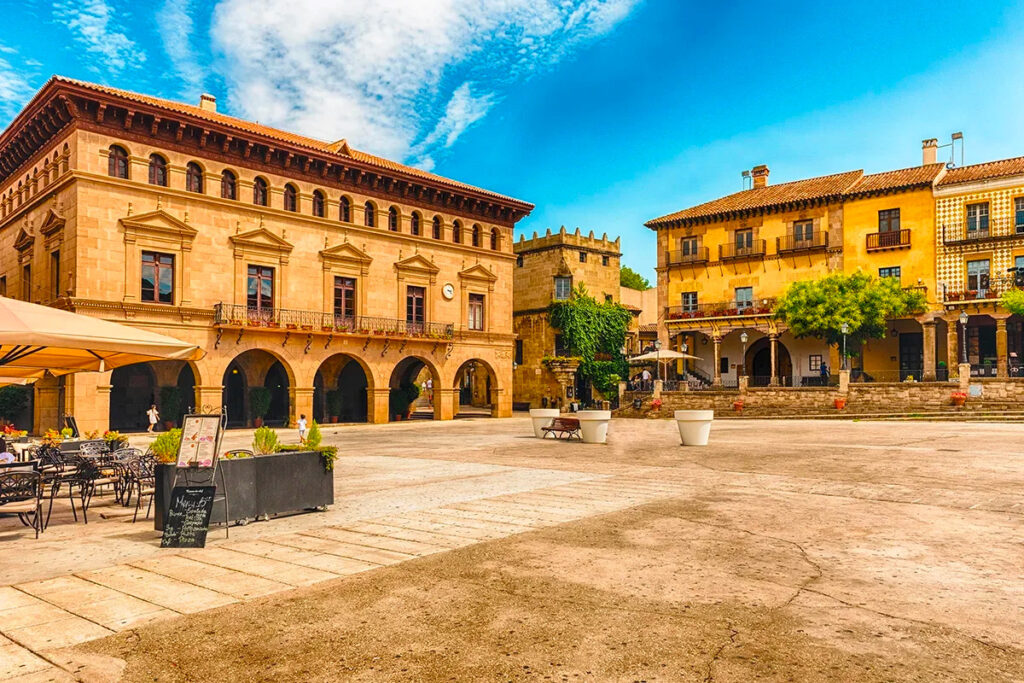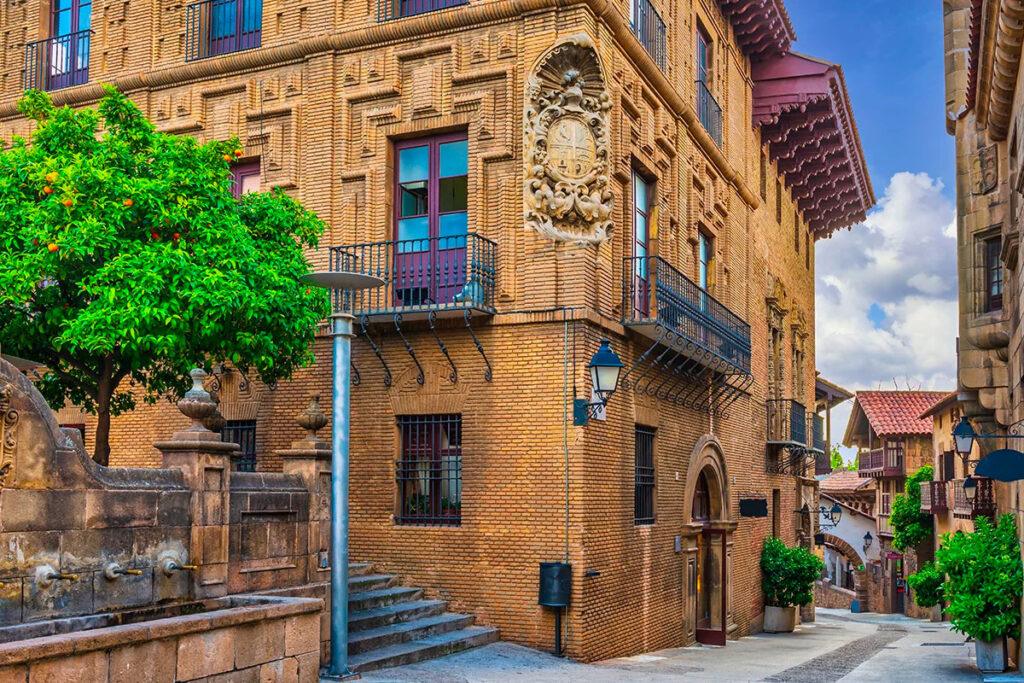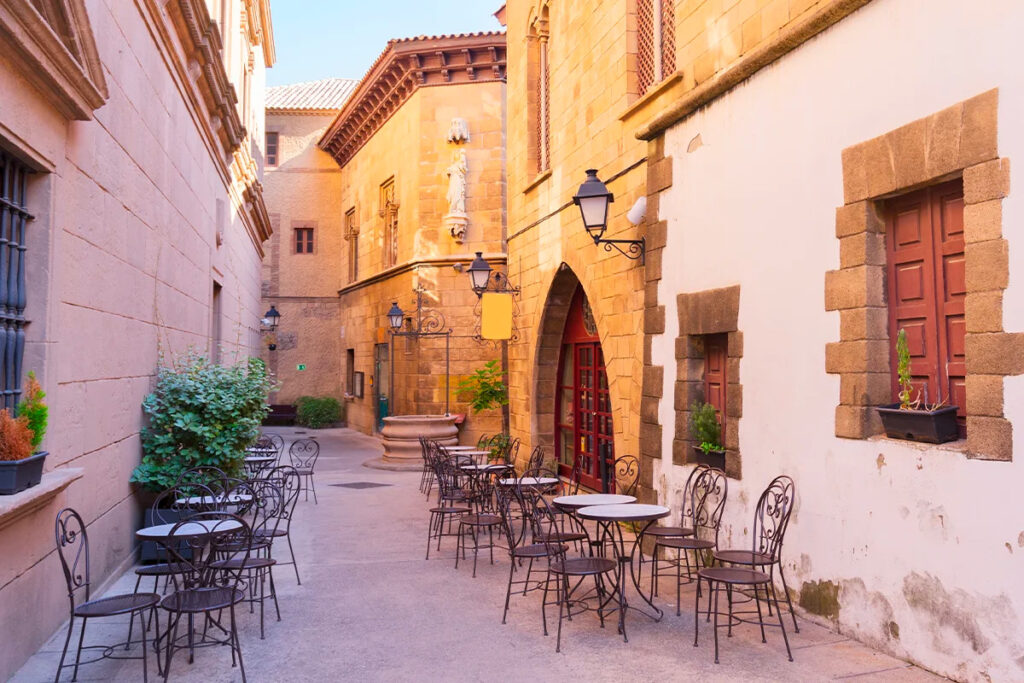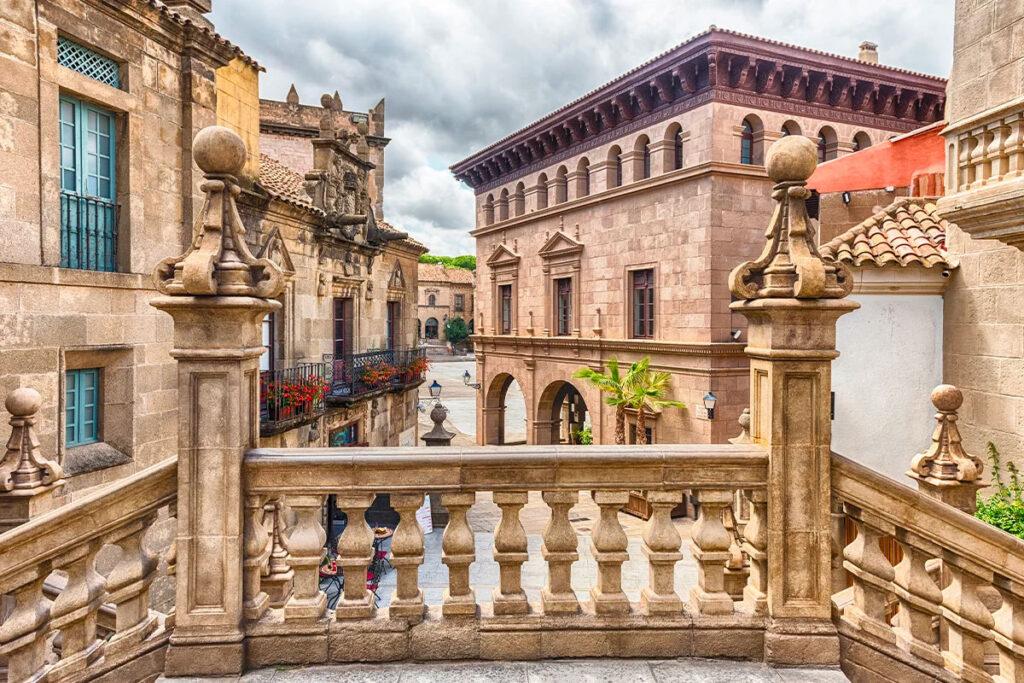Imagine stepping into a world where the rich architectural, cultural, and culinary heritage of Spain comes alive in one enchanting place.
This dream becomes a reality at Poble Espanyol, Barcelona’s captivating open-air architectural museum. Ready to unveil its secrets? Let’s embark on this exciting journey together!
- Experience the unique charm of Barcelona’s Spanish Village, Poble Espanyol!
- Explore Spain’s diverse architectural styles and cultural heritage with a stroll through its streets and squares.
- Enjoy art & culture, workshops & crafts, culinary delights plus exciting events & entertainment, an absolute must see when visiting Barcelona!
Discovering Poble Espanyol: Barcelona’s Spanish Village
Perched on Montjuïc hill, Poble Espanyol beckons explorers with its charm. Founded by Miquel Utrillo, Xavier Nogués, Francesc Folguera, and Ramón Reventós.
This open-air museum houses replicas of characteristic buildings from all parts of Spain, including a town hall, schools, shops, restaurants, and monastery. Poble Espanyol, established in 1929, has evolved significantly over time with the inclusion of new attractions like contemporary art projects and crafts following various renovations and expansions.
The Vision Behind Poble Espanyol
Poble Espanyol, conceived as a representation of Spain’s architectural and cultural diversity, was originally created for the 1929 World Fair. Architects Josep Puig i Cadafalch, Ramon Reventós, Francesc Folguera, and Xavier Nogués embarked on an extraordinary journey across Spain, drawing inspiration from its regions to recreate the essence of the country’s architectural styles in the Spanish Village.
Poble Espanyol currently houses 117 full-scale buildings, each symbolizing an aspect of Spain’s diverse regions. Visitors can immerse themselves in the soul of Spain, admiring traditional architecture and experiencing the diverse cultural heritage within this unique village on Francesc Ferrer street in Barcelona.
Experiencing Spanish Architecture at Poble Espanyol

With more than 100 life-sized replicas of renowned Spanish buildings, Poble Espanyol offers visitors an opportunity to traverse through Spain’s diverse architectural styles. Designed by architects Francesc Folguera and Ramon Reventós, in cooperation with art critic Miquel Utrillo and artist Xavier Nogués, the village showcases Andalusian, Catalan Romanesque, and vernacular styles from across the country.
Strolling Through Streets and Squares
Wandering through Poble Espanyol’s charming streets and squares, you’ll get a feel for the ambiance of Spanish towns and villages. The Plaza Mayor and several smaller squares are connected by picturesque streets, each reflecting the architectural styles of various regions such as Asturias, Aragon, and Castile-La Mancha, making it a unique place to explore.
The layout of Poble Espanyol’s streets and squares mimics Spanish town planning by showcasing representative buildings, streets, and squares from different regions. This provides visitors with an exciting glimpse into the architectural diversity and urban design found throughout Spain. Guided tours are available for those who wish to delve deeper into the architectural marvels of Poble Espanyol.
Art and Culture in Poble Espanyol

The Fran Daurel Foundation, a modern art museum within Poble Espanyol, will captivate art enthusiasts. The museum features works by renowned artists such as Picasso and Dalí, as well as pieces inspired by the ideas of Francesc Ferrer i Guàrdia, offering a feast for the eyes and the soul.
Beyond the museum, Poble Espanyol hosts a sculpture garden, featuring over 300 works by more than eighty artists, with prominent names like Picasso, Salvador Dalí, and Joan Miró among them. This impressive collection showcases the artistic talent and diversity that Spain has to offer.
Engaging in Workshops and Crafts

The unique handicraft center of Poble Espanyol serves as a creativity hub, epitomizing the preservation and beautiful display of traditional techniques. Visitors can participate in workshops and learn from skilled craftsmen working on various crafts, including leather products, ceramics, glass, jewelry and spanish guitars.
The handicraft center offers a variety of workshops, including contemporary textile craft workshops, traditional weaving workshops, hand embroidery workshops and therapeutic craft workshops for people with mental disabilities. Immerse yourself in the world of traditional crafts and take home a piece of Spain’s rich cultural heritage.
Culinary Delights: Restaurants and Food in Poble Espanyol

Experiencing Poble Espanyol’s authentic Spanish cuisine is an integral part of any visit. Restaurants such as La Font de Prades and Granja Rivero serve traditional dishes from the Spanish region of Catalonia, including rice dishes, cod, grilled meats, tapas, hams, cheeses, and specialties from different regions, accompanied by fine wines and olive oils.
For a more casual dining experience, visitors can also bring their own lunch and enjoy a picturesque picnic in one of Poble Espanyol’s designated picnic areas. With stunning views over Barcelona, it’s the perfect way to savor Spain’s culinary delights while surrounded by its architectural beauty.
Unforgettable Events and Entertainment
Besides being a showcase of Spain’s architectural and cultural heritage, Poble Espanyol also serves as an energetic hub for events and entertainment. The village hosts a variety of festivals, concerts, and clubs, including the popular Brunch in the City, La Terrazza, and Sala Upload. These events combine electronic music, gourmet gastronomy, and a festive atmosphere, with activities and workshops for all ages, including children. Family-friendly activities, such as the Creepy Family quiz-solving event and seasonal celebrations like Creepy Extreme, ensure that Poble Espanyol offers unforgettable experiences for visitors of all ages.
Planning Your Visit to Poble Espanyol

Poble Espanyol, conveniently nestled on Montjuïc hill and well-connected by public transport, is a must-visit for anyone touring Barcelona. The village offers various ticket options, including morning, evening, and special event tickets, catering to the preferences of every visitor.
While the summer months are perfect for visiting Poble Espanyol in the evening, the village is also a delightful destination during other seasons. With so much to see and do, it’s recommended to allocate at least 1.5-2 hours for your visit to fully appreciate the architectural, cultural, and culinary wonders that await you.
Nearby Attractions to Complete Your Barcelona Experience
Apart from Poble Espanyol, Montjuïc hill brims with other attractions to enrich your Barcelona journey. The Joan Miró Museum, just a short distance away, is home to over 10,000 paintings, drawings, sculptures, stage designs, and carpets from the renowned Spanish artist.
Another nearby attraction is the architectural museum, Museu Nacional d’Art de Catalunya (MNAC), which houses masterpieces from the Romanesque, Gothic, and Modern collections, as well as works by El Greco, Zurbarán, Velázquez, and Rubens in the Renaissance and Baroque art exhibitions. These cultural institutions, along with Poble Espanyol, provide a comprehensive taste of Spain’s artistic and architectural heritage.
Summary
In conclusion, Poble Espanyol is a captivating destination that brings the essence of Spain to life in one enchanting location. From its rich architectural history to its vibrant art and culture, engaging workshops, scrumptious culinary delights, and unforgettable events, Poble Espanyol offers a unique and immersive experience for visitors of all ages. So why wait? Embark on an unforgettable journey through Spain’s architectural and cultural heritage at Poble Espanyol, and let the magic of this Spanish Village in Barcelona sweep you off your feet!
Practical info
It’s best to buy tickets to Poble Espanyol in advance. You will then avoid standing in a long queue and avoid the risk that all tickets have been sold out, which happens very often in the case of this monument.
- Address: Av. de Francesc Ferrer i Guàrdia, 13, Sants-Montjuïc, 08038 Barcelona, Spain
- Buy Tickets on GetYourGuide
